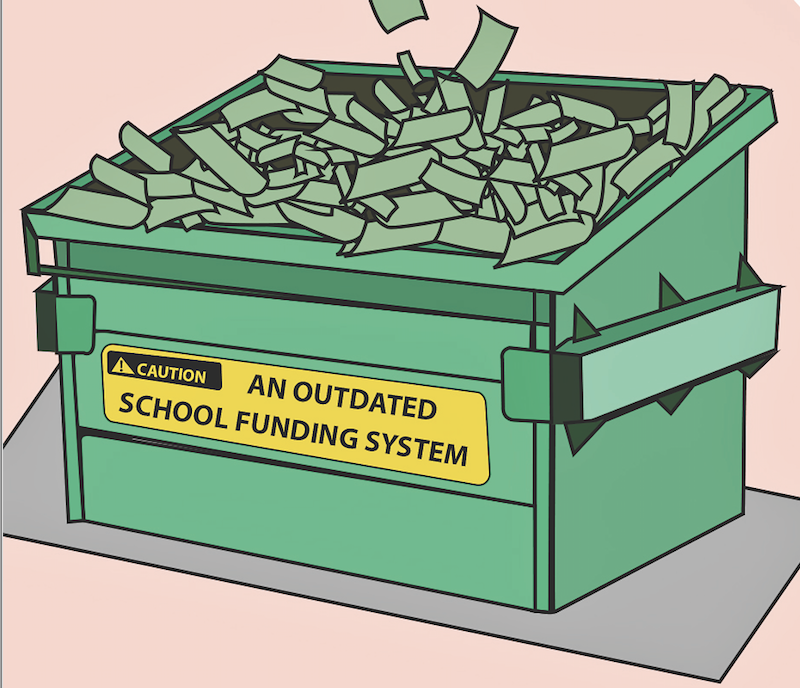Texas’ school funding system is defective
Untangling the mysteries behind local educational financing and a push to vote for education
From the clunky air conditioners to broken pipes and swarms of aggressive bees, this year at Bowie has not been a walk in the park. Students can only hope that one day their school will have some basic heating, but right now, they’re wondering why AISD is unwisely spending state and local money on such inefficient, quick fixes, whilst seemingly avoiding the main solutions that students have been demanding for years.
The topic of school funding at Bowie has always been a cloudy one, more often than not leaving students uninvolved, confused, and in the dark about where their school’s money is going.
Some might say that, “in the state of Texas, throwing money at the wrong issues won’t solve any problems, it will only create them,” and leave it at that, but this simply won’t solve any issues by itself. Instead, those who desire to change how Texas schools are funded must get involved in the extensive process of the state legislature and rule in favor of education.
The Texas state legislature could sit on piles of money and still not know what to do with all of it. It’s time for parents and students to stop oversimplifying the lack of sufficient school funding for Bowie, AISD, and the state at large by asking themselves if throwing more and more money at a broken system has worked in the last twenty years since the re-capture program, also known as Robin Hood plan was introduced.
As some may already know, Texas enacted the “re-capture” plan in 1993 with the intent to share the wealth and equalize public education. The law “recaptured” property taxes and redistributed that money to district across Texas with less wealthy campuses receiving more of these funds.

The problem is that these once-poor campuses are still receiving the majority of the money that comes from the Robin Hood plan, even if it means their schools are in great condition, with massive theaters, robust CTE classrooms, and lots of perks for their students. Although this plan was created with the best intentions, it clearly isn’t benefiting Bowie for the state to take away more than half the property taxes from the local population that could be used to fix our problems.
Public schools in Texas are funded by local property taxes as well as some of the state’s general revenue. Lowering the already-minimal amount of funds some schools receive from these taxes because of the Robin Hood plan is bound to create problems in the long run.
The source of strange spending and lack of school funding in Texas starts in state government. The Texas legislature creates a budget for education every two years. When electing representatives, the politician’s views on funding education must be taken into account, especially considering their contribution to the state budget. One of the major problems Texas faces is the domination of republicans in the legislature whose agenda does not prioritize education.
According to Teach the Vote, democrats in Texas have been making a push to restore the $5.4 billion cut from public education funding in 2011 and $1.7 billion cut in 2017. On the other hand, republicans want Texas school districts to spend at least 65 percent of their current funding before receiving any additional funding. If students desire change for their school, they must stay neutral and vote for the most qualified politicians that will better their school districts and their schools.
There are many issues at Bowie that require more funds to solve, the first of which are the basics of stable infrastructure. Once there is the initiative to supply funds for Bowie and a push to provide a fair system for education funding is established, students and their issues should be the priority concern for AISD. For example, one of these issues is the need for more special education teachers around Texas.
The problem has grown so large that some public schools in Texas are denying enrollment to kids with disabilities due to the financial liability. According to the Houston Chronicle, Texas needs up to $3.3 billion to bring special education services up to national standard.
Additionally, according to the National Association for College Admission Counseling, Texas legislature only requires one counselor for every 250 students, which is a massive number for a single person. Texas schools should direct funds to better balance the ratio of students to counselors.
The bottom line is that the state of Texas has a serious funding problem when it comes to funding their schools, and it’s causing a number of issues within their schools to be seemingly overlooked.
To conquer these issues, the state must look at possible solutions found in other places around the country.
In many states, a sizable portion of school funding is generated through state income tax, which is not very effective in Texas, thanks to the Robin Hood plan. Instead, Texas generates revenue through other basic taxes, such as a percentage of sales taxes, optional taxes and through bonds. This revenue, which, although it has kept education afloat, could use many improvements. To start, AISD should compare themselves with other educational systems and see what can be assimilated from schools around Texas.
Texas communities who want to change the school funding system are obligated to speak on these issues and to get superiors involved. The future of a safe, well educated youth should be a priority to the state. What students need are basic resources and faculty to help them thrive. AISD does all they can to create this environment for their students, but when they need more, it becomes obvious that there’s a serious funding problem that the district and state must find a solution to.
Your donation will support the student journalists of James Bowie High School. Your contribution will help cover our annual website hosting costs. Any contributions made through this service are NOT tax deductible. If you would like to make a tax deductible donation OR to subscribe to our print edition, please contact us at [email protected].







